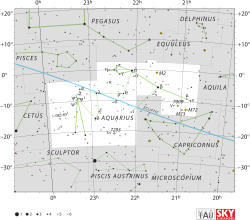Omega2 Aquarii
| Observation data Epoch J2000 Equinox J2000 | |
|---|---|
| Constellation | Aquarius |
| Right ascension | 23h 42m 43.34473s[1] |
| Declination | –14° 32′ 41.6523″[1] |
| Apparent magnitude (V) | 4.49[2] |
| Characteristics | |
| Spectral type | B9 V[3] |
| U−B color index | –0.12[2] |
| B−V color index | –0.04[2] |
| Astrometry | |
| Radial velocity (Rv) | +3[4] km/s |
| Proper motion (μ) | RA: +99.28[1] mas/yr Dec.: –66.32[1] mas/yr |
| Parallax (π) | 21.96 ± 0.26 mas[1] |
| Distance | 149 ± 2 ly (45.5 ± 0.5 pc) |
| Details | |
| Radius | 1.94 ± 0.06[5] R☉ |
| Surface gravity (log g) | 4.22 ± 0.03[5] cgs |
| Temperature | 10,504 ± 91[5] K |
| Rotational velocity (v sin i) | 148[6] km/s |
| Other designations | |
Omega2 Aquarii (ω2 Aqr, ω2 Aquarii) is the Bayer designation for a triple star[8] system in the equatorial constellation of Aquarius. It can be seen with the naked eye, having an apparent visual magnitude of 4.49.[2] The approximate distance to this star, 149 light-years (46 parsecs), is known from parallax measurements taken during the Hipparcos mission.[1]
The primary component of this system is a massive, B-type main sequence star with a stellar classification of B9 V.[3] This star has nearly double the radius of the Sun[5] and is spinning rapidly with a projected rotational velocity of 148 km/s.[6] The outer atmosphere has an effective temperature of 10,504 K,[5] giving it the blue-white hue of a B-type star.[9]
There is a close orbiting stellar companion of unknown type, with a third component at an angular separation of 5.7 arcseconds. The latter is a K-type main sequence star with a visual magnitude of 9.5.[8] This system is among the 100 strongest stellar X-ray sources within 163 light-years (50 pc) of the Sun. It is emitting an X-ray luminosity of 1.2 × 1030 erg s−1.[10]
References
- ^ a b c d e f van Leeuwen, F. (November 2007), "Validation of the new Hipparcos reduction", Astronomy and Astrophysics, 474 (2): 653–664, arXiv:0708.1752, Bibcode:2007A&A...474..653V, doi:10.1051/0004-6361:20078357.
- ^ a b c d Nicolet, B. (1978), "Photoelectric photometric Catalogue of homogeneous measurements in the UBV System", Astronomy and Astrophysics Supplement Series, 34: 1–49, Bibcode:1978A&AS...34....1N.
- ^ a b Houk, Nancy (1978), Michigan catalogue of two-dimensional spectral types for the HD stars, vol. 4, Ann Arbor: Dept. of Astronomy, University of Michigan, Bibcode:1988mcts.book.....H.
- ^ Wilson, Ralph Elmer (1953), General Catalogue of Stellar Radial Velocities, Washington: Carnegie Institution of Washington, Bibcode:1953GCRV..C......0W.
- ^ a b c d e Fitzpatrick, E. L.; Massa, D. (March 2005), "Determining the Physical Properties of the B Stars. II. Calibration of Synthetic Photometry", The Astronomical Journal, 129 (3): 1642–1662, arXiv:astro-ph/0412542, Bibcode:2005AJ....129.1642F, doi:10.1086/427855.
- ^ a b Royer, F.; Zorec, J.; Gómez, A. E. (February 2007), "Rotational velocities of A-type stars. III. Velocity distributions", Astronomy and Astrophysics, 463 (2): 671–682, arXiv:astro-ph/0610785, Bibcode:2007A&A...463..671R, doi:10.1051/0004-6361:20065224.
- ^ "105 Aqr -- Star in double system", SIMBAD, Centre de Données astronomiques de Strasbourg, retrieved 2008-05-16.
- ^ a b Eggleton, P. P.; Tokovinin, A. A. (September 2008), "A catalogue of multiplicity among bright stellar systems", Monthly Notices of the Royal Astronomical Society, 389 (2): 869–879, arXiv:0806.2878, Bibcode:2008MNRAS.389..869E, doi:10.1111/j.1365-2966.2008.13596.x.
- ^ "The Colour of Stars", Australia Telescope, Outreach and Education, Commonwealth Scientific and Industrial Research Organisation, December 21, 2004, retrieved 2012-01-16.
- ^ Makarov, Valeri V. (October 2003), "The 100 Brightest X-Ray Stars within 50 Parsecs of the Sun", The Astronomical Journal, 126 (4): 1996–2008, Bibcode:2003AJ....126.1996M, doi:10.1086/378164.

